News
Many state hospitals go digital with home-grown system
A simple but unique home-grown solution as opposed to a very expensive system is working successfully in the digitization of the National Cancer Institute (NCI) at Maharagama and several other hospitals across the country.
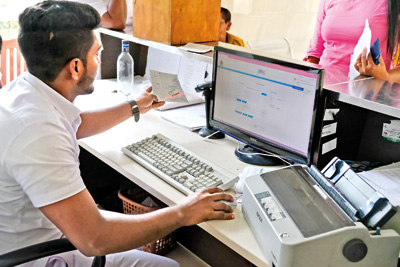
A new patient getting digital registration at the NCI . Pix by Amila Gamage
As the Sunday Times sees the Hospital Information Management System (HIMS) now in operation at the nearly 1,000-bed NCI, it is Senior Registrar in Health Informatics, Dr. Nishan Siriwardena, who reiterates that “our system works well without costing resource-poor Sri Lanka exorbitant sums which we can ill-afford”.
This HIMS has been developed in Sri Lanka, installed and remotely monitored by Sri Lankans and is also maintained by Sri Lankans. Supported by the Health Ministry, the Director of Health Information, Dr. Anil Samaranayake is extending a strong helping hand and has initiated a national plan to digitize all state hospitals, the Sunday Times understands.
In addition to the NCI, currently the HIMS is in use at the Castle Street Hospital for Women and the Lady Ridgeway Hospital (LRH) for Children in Colombo; the Teaching Hospitals of Kalubowila, Ragama, Kandy, Peradeniya, Kurunegala and Jaffna; and the Hospitals of Matale and Gampola.
The National Institute of Mental Health, Angoda, and the Batticaloa Hospital are about to include it in their management, it is learnt.
The Sunday Times sees the ‘nerve-centre’ at the NCI, with four developers at their computers – a small operation but with a major reach, before visiting the Medical Records Room, the Radiology Department, the Dental Unit and the wards where it is working well.
In the wards, nurses and doctors can access patient records on tabs and computers, while at the admission point, in an office collecting all the data are the Medical Records Officer Dr. L.D. Ratnasiri and his team.
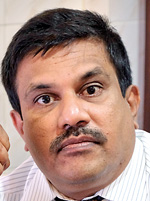
Dr. Athula Senaratne

Dr. Nishan Siriwardena
Queues seem to be a thing of the past, with Dr. Ratnasiri reiterating that the digital registration of patients under the HIMS has helped to do away with snaking polim and delays faced by patients.
The moment a new patient walks in, all details about him/her are fed into a computer and a card with a Personal Health Identification Number (PHIN), unique to him/her is issued. This helps the patient to join the system and allows the doctors whether in the ward or at clinics to have access to the record without someone taking it physically from one point to another, the Sunday Times learns.
“When a patient comes in, all the data are collected here not only to help clinicians to map out the treatment strategy after examining them but also to collate national data.
This will help us to get information on the disease burden in Sri Lanka; the demographic distribution of particular malignancies and analyse them to guide national interventions through policy and allocation of funds,” says Dr. Ratnasiri.
Our next visit is to the Radiology Department.
We look on in amazement as Consultant Radiologist Dr. Uditha Kumarasena dictates: “No evidence of lung metastasis” and the sentence is up on the computer screen, without any words being keyed in.
This is the newest feature introduced recently under the HIMS, where the Consultant Radiologist can verbally dictate the findings on the radiology tests of patients which are picked up by the computer and shown on the screen as the written word.
Stressing that the tagline of this whole process is “less paper”, Dr. Kumarasena who has experienced the value of the Picture Archiving & Communication System (PACS – now available at the NCI under the HIMS) when he was working in the United Kingdom, explains that all images such as X-rays, CT scans and mammograms are digitally stored in a big computer server and distributed to clinics and wards through the click of a button.
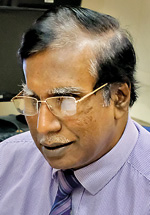
Dr. L.D. Ratnasiri
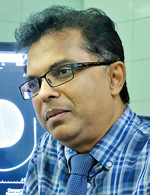
Dr. Uditha Kumarasena
“There is no need to print any of these X-rays etc,” he says, adding that “the department is now filmless. Image manipulation on the computer can also enhance radiology reporting.”
There is an image library making retrieval of radiological tests easy as well. Usually, patients are given these films to take home and either forget to bring them whenever they come back for treatment or lose them, it is learnt.
Film costs come from Dr. Siriwardena who says that 1 CT film costs Rs. 600 and 1 X-ray Rs. 400. However, these costs are a thing of the past now with the implementation of the HIMS and PACS.
The HIMS will also help overcome a new challenge – the scarcity of films with the manufacture of films dropping around the world and being sold at a higher cost, as the developed world has gone digital and only African and Southeast Asian countries use films.
Radiology test results stored digitally are of help to clinicians in making evidence-based decisions – whether the patient has responded to treatment, whether the cancer is in remission and whether the treatment such as chemotherapy, radiotherapy or surgery has worked or failed, says Dr. Kumarasena, underlining the fact that there can be objective assessment with clear evidence.
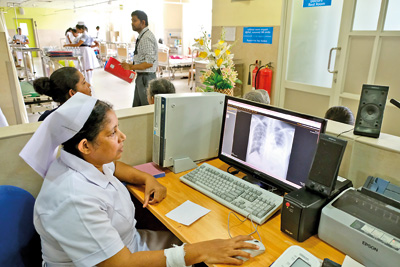
Nurses in wards accessing records on the computer
Generally, PACS when imported costs a lot of money but here it has been developed locally saving much money for the country, he says.
At the Dental Unit, Dr. Athula Senaratne is at the keyboard of a computer retrieving a detailed case history including X-rays, before taking a look into the mouth of the patient on the dental chair.
This home-grown HIMS was developed in 2012 with a grant from Ahmad Tea as part of the large donation the company extended to set up the state-of-the-art Razavi Medical Complex. The Sri Lanka Leukaemia Foundation, United Kingdom, had supported the project by donating the research and development laboratory.
It became the “baby” of Dr. Siriwardena when he set his sights on gaining a Postgraduate qualification in Health Informatics, with the then NCI Director Dr. Kanishka Karunaratne followed by Dr. G. Wijesuriya and Dr. Wilfred Kumarasiri being very supportive.
Currently, the Health Ministry has six doctors including Dr. Siriwardena trained in America in PACS implementation. This training had been organized by the then Director of Health Information of the ministry, Dr. Champika Wickramasinghe. It is this resource pool that can be used for the expansion of the project countrywide, it is learnt.
Incidentally, the catalyst for promoting health informatics was Prof. Vajira Dissanayake of the Colombo Medical Faculty. Currently there are more than 150 doctors trained in Health Informatics who are promoting digital health in the state health sector.
The “incubator” for the HIMS including planning, development and evolution, meanwhile, was the NCI, explains Dr. Siriwardena, pointing out that it captures all technology advancements in healthcare delivery and gives it to the country at minimal cost. Back in 2012, it included a basic but crucial information module such as admissions, discharges and transfers. By 2015, the NCI started sharing this digital information with the Health Ministry.
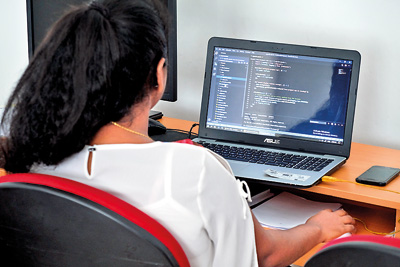
A software developer at work at the NCI
Now the HIMS is implemented at ward-level in the NCI.
“We can use it in all the 28 wards, the three Intensive Care Units (ICUs – Medical, Surgical and Paediatric), the Emergency Treatment Unit (ETU) and the Day Chemotherapy Unit, but are having some challenges due to the lack of resources to secure the hardware (computers),” he laments, adding that even though 18 wards use HIMS, the hardware even in some of them is inadequate.
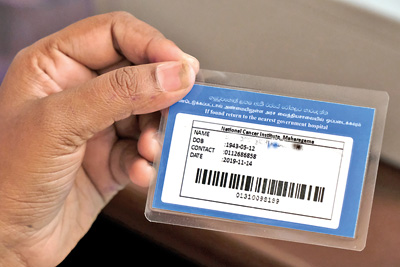
A card with the Personal Health Identification Number is issued to each patient
| Do state hospitals need a branded PACS when there is a good local system, ask health sources | |
| The Sunday Timesunderstands that there are “unnecessary” moves to instal a foreign-linked Picture Archiving & Communication System (PACS) in state hospitals at an alleged enormous cost of around Rs. 5 billion.Is this necessary, is the question being asked in health circles. “We already have a vibrant Hospital Information Management System (HIMS) which includes PACS at the NCI and some other hospitals. Why can’t we strengthen this rather than fork out billions to a foreign country,” stressed many sources. They added that Sri Lanka needs to encourage and foster local talent and that is what is happening at the NCI where all software modifications are being done by Sri Lankans. The reporting system had also been developed locally at the NCI and then replicated in the other hospitals at minimal cost. If PACS is installed with foreign collaboration, there will be many ongoing issues and exorbitant payments required for licensing and the addition of new systems, bleeding the country of precious foreign exchange, the sources added, asking: Can the country afford it? Meanwhile, branded PACS systems are very expensive, we learn, but what is in operation at the NCI and the other hospitals is open-sourced software. A national roll-out of this HIMS will not only help all state hospitals but also the Health Ministry, many sources told the Sunday Times. It would help gather real-time data on important aspects such as morbidity and mortality of different illnesses, hospital admissions, disease trends and much more, they said, pointing out that it would be a boon to the Medical Statistics Unit which puts out the eIMMR (Indoor Morbidity and Mortality Record). |

